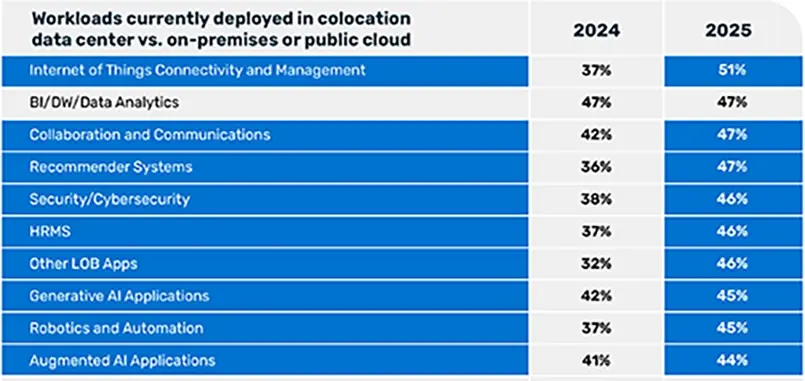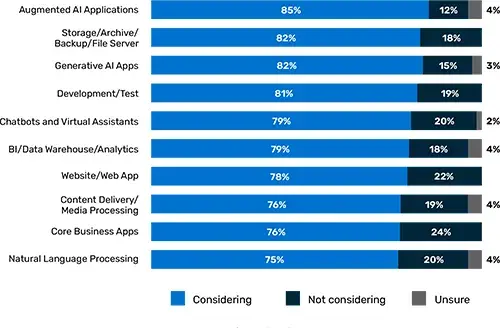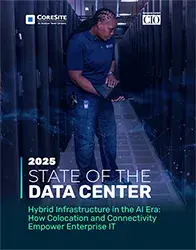
AI Shifts the Balance of Where to Host Workloads: The 2025 State of the Data Center Report Explains Why
Hybrid IT is a balancing act. On-premises, colocation, cloud providers and hyperscalers all have roles, and IT leaders are increasingly adept at distributing workloads where they deliver the highest value. The 2025 State of the Data Center report by Foundry and CoreSite digs deep into how AI and interconnection are shaping future-ready hybrid IT.
Nearly All Enterprises Choose a Hybrid IT Model
In its early days, hybrid IT strategies focused on integration and interoperability. Now, it’s the go-to model to optimize IT infrastructure and operations, with 98% of IT leaders saying they have adopted hybrid IT or plan to adopt it, according to the 2025 State of the Data Center report.
In the early 2000s, cloud computing provided an environment for accelerating digital transformation. Some enterprises went all-in on public cloud. Now, IT leaders are leveraging greater interconnection agility to distribute and optimize workloads in hyperscale, on-premises and colocation data centers. We’ve moved on from cloud-only to “cloud-smart” and, by extension, to “data-center smart.”
The 2025 report highlights the increasing use of hybrid cloud models – infrastructure designed to include both private and public clouds. In 2025, 62% of respondents currently use hybrid cloud, up from 55% in 2022. Another 32% say in the 2025 report they expect to adopt hybrid cloud within 12 months.
The colocation component of hybrid IT is also growing as IT leaders navigate their cloud-smart journeys and take advantage of interconnection capabilities. The 2025 survey finds that colocation facilities host a greater percentage of workload types than they did in 2024. More about this year-over-year shift below.

Where You Place Workloads Matters
Workload placement decisions take center stage as leaders fine-tune their hybrid IT environments. Two trends illustrate the adjustments. The first is the rising percentage of workloads that have been repatriated into colocation data centers. The second is the top public cloud workloads that IT leaders are considering moving to colocation.
Let’s look at workloads already in colocation. The 2025 report studied 22 types of workloads. the top 10 – based on the percentage change between 2024 and 2025 – are shown in Figure 1. Of the 22 types of workloads, 15 increased their colocation presence. Also, after IT organizations migrated workloads from the cloud into on-premises environments, they moved many of them to colocation, motivated primarily by three criteria – cost, control and connectivity.

Figure 2. Most of the surveyed IT leaders are considering moving workloads to colocation within the next 12 months, according to the 2025 State of the Data Center report.
To provide context of the change since last year, we note that in the 2024 State of the Data Center report, 37% of those surveyed said their organization repatriated apps or workloads, including databases, storage and AI/machine learning (ML) apps.
Now, the second trend. The chart in Figure 2 shows the top 10 workloads likely to move to colocation within 12 months. Augmented AI applications top the list and generative AI (GenAI) is a close third. The takeaway? AI is a game-changer for hybrid IT workload placement.
Why AI Shifts the Balance of Where to Host Workloads
It seems like AI is everywhere – because it is! When asked about AI in the 2025 survey, 68% of IT leaders said it’s already reshaping IT operations. The charts above show how AI workloads, including GenAI, augmented AI and recommender systems, are gravitating to colocation. In part, they’re migrating because colocation offers the top three AI-enabling capabilities that IT leaders seek: high-density power and cooling (54%), direct connection to cloud providers (51%) and support for high-performance computing infrastructure (49%).
AI-ready colocation data centers also attract AI workloads for other reasons:
- Flexibility to leverage both clouds and colocation, so AI workloads can be placed where they meet business objectives
- A predictable cost structure and ability to amortize hardware investments
- Expertise in hosting and managing high-density workloads
- Partnerships with a growing ecosystem of AI solution vendors
You may be surprised that some AI workloads are staying on-prem, given the general consensus that AI requires massive computing capabilities. It’s testament that on-prem has a role to play in the age of AI, and that use cases, and business cases, influence where AI workloads are best located.
“[Colocation providers] are the waypoint, the enabler, in my transition to the cloud,” says the Vice President of IT Services for an 1,800-employee organization in the banking industry. “If they do not have hybrid connectivity, then they are not able to make connections between on-prem, the colo and the cloud.”
2025 State of the Data Center Report
The Hybrid IT Balancing Act
IT leaders have a lot of options for workload distribution. There’s a lot to weigh when you’re evaluating requirements, opportunities and cost. Yet few if any enterprises are backing away from hybrid IT. Fortunately, enterprises can start small and expand. Colocation is positioned nicely in the middle between on-prem and cloud. Interconnection capabilities are key to easily and affordably moving workloads. Direct cloud connection reduces egress costs and latency, a critical factor for workloads that depend on real-time data.
We think it will be valuable for you to take a few minutes to read the 2025 State of the Data Center report. The 300+ CIOs, CTOs and other IT decision-makers who shared their strategies and insights represent a cross-section of industries. And, as always, if you have questions about colocation and how it fits into your hybrid IT strategy, please contact us. It’s exciting, and a privilege, to help our customers successfully build and execute their strategies.
Know More
Now in its sixth year, the 2025 State of the Data Center research, conducted by Foundry, surveyed 300 CIOs, CTOs and other IT decision-makers representing a variety of industry sectors. In addition to the online survey, Foundry conducted in-depth interviews with seven senior technology executives from enterprise organizations in the financial services, healthcare, retail and software-as-a-service (SaaS) sectors. Quotes from those interviews are included throughout the report, with the understanding that subjects would not be identified by name or company so they could speak freely about their data center strategies.
Download, read and share the 2025 State of the Data Center report.











